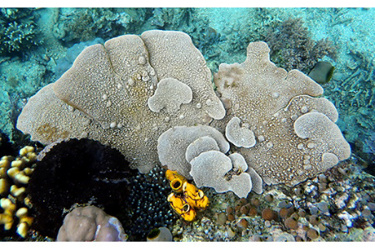Sponges As Biomonitors Of Micropollution

Sponges are filter feeders that live on particulate matter – but they can also ingest microscopic fragments of plastics and other pollutants of anthropogenic origin. They can therefore serve as useful bioindicators of the health of marine ecosystems.
Pollution of the world‘s oceans owing to anthropogenic input of plastics and other industrial wastes represents an increasing threat to the viability of marine ecosystems. – And because such pollutants accumulate in fish, crustaceans and mollusks, they enter the food chain and can be ingested by human consumers. Microparticles with dimensions of less than 5 mm present a particularly insidious problem. This class of pollutants includes microplastics and textile fibers, as well as synthetic chemicals found in consumer products such as household cleansers and cosmetics. It is therefore imperative to develop methods for quantifying the magnitude of the threat in order to develop effective measures to mitigate it. In a new publication in the journal Environmental Pollution, a research team led by LMU’s Professor Gert Wörheide (Department of Earth and Environmental Sciences, and GeoBio-Center) shows that marine sponges have great potential as bioindicators for the monitoring of microscopic pollutants in the seas.
Sponges are sometimes referred to as the ocean’s vacuum cleaners. They feed on tiny particles suspended in the currents, by filtering them from the seawater that passes through their highly porous tissues – which are supported by mineralized skeletons in many species. To assess their utility as bioindicators for microparticulate pollutants, Wörheide and colleagues studied 15 samples of a type of mineralized sponges belonging to the class known as ‘demosponges’ from a coral reef off the coast of the island of Bangka in Northern Sulawesi (Indonesia). “We chose this site because Southeast Asia is a hotspot for plastic pollutants in the oceans”, says Elsa B. Girard, lead author of the study. Girard recently graduated from the Master’s Program in Geobiology and Paleobiology at LMU, and her contribution to the paper was part of her Master’s thesis. “In light of the impact of global warming, and the overexploitation of marine resources, local sponge species could act as useful biomonitors of micropollutants, and help us to develop appropriate measures to reduce the deleterious effects of these substances on reef communities“, she explains.
In cooperation with specialists from the SNSB- Mineralogical State Collection in Munich and LMU’s Department of Chemistry and Center for Nanoscience (CeNS), the biologists used two innovative methods to examine the samples collected from the reef. With the aid of two-photon excitation microscopy (TPE), they confirmed that sponges indeed incorporate microparticles into their tissues. Then they used Raman spectroscopy to characterize the nature of the particles themselves. The data obtained with the second technique revealed the presence of no less than 34 different types of microparticles in sponge tissues. The spectrum ranged from plastics such as polystyrene to cotton and titanium dioxide (TiO2). TiO2 is used in dyes and paints, as well as being a component of sunscreen lotions. Furthermore, the variation in the composition of microparticles in the different samples appears to reflect spatial variations in particle type in the surrounding water.
The researchers detected between 90 and 600 particles per gram of dried tissue in their sponge samples. “Since sponges can weigh up to several hundred grams, we estimate on the basis of these results that each can accumulate more than 10,000 particles”, says Wörheide. “This makes them promising candidates for the task of monitoring the levels of anthropogenic microparticle pollution in the oceans.” With the exception of mollusks, few other species have the properties required of marine bioindicators. According to the authors of the study, sponges have several other “qualifications” for the job. They are abundant and are continuously active as filter-feeders. Moreover, measurements of pollution levels can be carried out on tissue samples (biopsies) without affecting the viability of the organisms.
Environmental Pollution 2020
Source: Ludwig-Maximilians-Universität München
